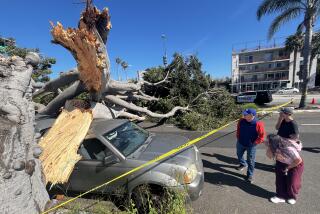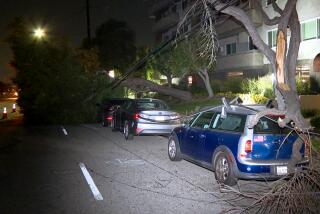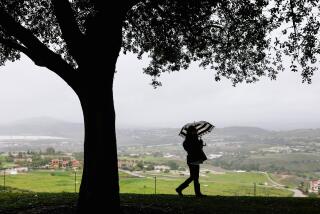Alaskan Storm Puts Southland in Deep Freeze
A powerful Alaskan storm slammed into the Southland Wednesday, scattering snow from the sands of Malibu to the edge of the Mojave Desert, closing parts of interstates 5, 10 and 15 and whipping up rainy winds that knocked out power in more than 177,000 households.
The onslaught was blamed for the deaths of at least six people.
A 3-year-old Agua Dulce girl died in a head-on collision on a snowy road near Newhall, and a man in his 20s was killed in a smash-up on the rain-slick San Bernardino Freeway.
Winds that had been clocked as high as 100 m.p.h. on Tuesday night toppled a power pole in Bakersfield onto the car of Miguel Delgado, 57, of McFarland, killing him, the California Highway Patrol reported.
Search Abandoned
As Wednesday night fell, Coast Guard and Navy rescuers abandoned their search of the waters off San Nicolas Island for three sea-urchin divers in wet suits who went into the water on surfboards when their San Pedro-based boat foundered in high seas on Tuesday night.
Six other crew members were plucked safely from the water by a Navy helicopter Wednesday afternoon. They were taken to an aircraft carrier that was on maneuvers in the area. All six were reported in good condition. The Coast Guard added that, based on information from the survivors, there was no hope that the other three had survived. (See story on Page 3.)
Another Navy helicopter rescued five people and a dog from a sinking fishing boat off San Clemente Island just after dawn Wednesday.
The storm, which had brought .33 of an inch of rain to downtown Los Angeles by mid-evening, seemed to be weakening, said Dan Bowman of Weather Data Inc., which provides forecasts for The Times.
“The storm is drawing in a mass of drier air from the Southwest and that will take some of the moisture out of it,” he said.
Bowman forecast that “there may be a few thunderstorms” this morning “and some rain” the rest of today but added that “by Friday it should start to clear.”
However, gale warnings were issued for the outer and inner waters off Southern California and a heavy surf with waves as high as eight feet was predicted. Officials warned owners of coastal property of possible damage when high tide is reached at 6 a.m. today.
The National Weather Service said the next storm churning in the North Pacific could bring a chance of showers late Saturday.
For people who only had to enjoy the unusual view, the rare snow that frosted the varied Southland terrain--as deep as six inches in some low-lying areas--looked like “a winter wonderland,” said Elizabeth Wiecheck, executive director of the Santa Monica Mountains Restoration Trust.
In the mountains, between 2 1/2 and 3 feet of snow covered the ground at Tehachapi. About a foot and a half was reported at Mt. Wilson in the San Gabriel Mountains. Big Bear, in the San Bernardino Mountains, reported 12 inches. Up to another foot of snow was expected in the high country overnight, the weather service said.
Downtown, the snow level reached the 26th floor of the Arco Plaza, where accountant Bill Metzler and his colleagues saw flakes falling outside their office windows.
“It (snow) came down mixed with the rain for about 45 minutes,” Metzler said. “Of course, we don’t know how many floors down it lasted.”
Overall, in its fierce swath across the Southland, the “whacking big storm,” as Deputy Los Angeles Mayor Mike Gage called it:
- Closed 50 miles of Interstate 5 above Castaic indefinitely, as big-rig trucks jackknifed in snow on the heavily traveled road. It also indefinitely shut down Interstate 15 north of San Bernardino above the Cajon Pass as well as Interstate 10 between Cabazon and Beaumont and parts of the Ortega Highway, linking Orange and Riverside counties. Parts of Angeles Crest Highway also were closed.
- Kept about 16,000 schoolchildren out of classes as four of the five school districts in the Santa Clarita Valley closed Wednesday, and will likely be closed today.
- Tripled the number of traffic accidents. In Palmdale, the CHP was so busy that it asked people to come in to its offices and fill out their own reports on minor accidents.
- Swept the streets of homeless, as the cold sent them scurrying to already-crowded shelters. “We found three people this morning actually huddled in our alcove under blankets,” said Maxene Johnston, spokeswoman for the downtown Weingart Center, one of the largest of the Skid Row shelters, which was “at or above” its 600-person capacity.
- Kept utility crews on the job to restore power knocked out by downed tree limbs and icy lines. More than 177,000 customers served by the Los Angeles Department of Water and Power and Southern California Edison lost service at one time during the storm. About 14,000 people, mostly in Central Los Angeles, were still without power late Wednesday. About 40,000 customers in Kern County were left without power by the high winds, and another 48,000 in Northern California were in the dark during part of the storm. The storm doubled the use of natural gas in homes, a Southern California Gas Co. spokeswoman said.
- Caused the closure of the landmark Stearns Wharf in Santa Barbara, after two vessels broke loose from their moorings in the high winds.
The storm--which brought downtown daytime temperatures in the 40s that seemed even colder with the wind-chill factor--gave Southern Californians a taste of Eastern winters.
“It’s as cold as . . . I won’t say the rest,” Roberta Johnson, secretary at the San Fernando Mission in Mission Hills, said piously.
In Los Angeles, the city’s homeless jammed into missions and shelters for warmth.
“People are still coming in . . . we made more room at the inn if you will without putting straw on the floor, moved desks out and beds into offices,” the Weingart Center’s Johnston said.
City streets were virtually empty of homeless, and those in the shelter, she said, “seem very grateful and better behaved than usual . . . we think that people are more desperate.”
Rhonda Meister, director of St. Joseph Center, a nonprofit social service agency in Venice, said that while some homeless are staying in their beachfront encampments, “large numbers of people have been asking about shelters today. It’s serious. The homeless are taking this weather very seriously.”
Los Angeles city officials said they would continue efforts to house the homeless during the cold spell, both by handing out vouchers and opening city buildings. The city is acting under a policy adopted last summer which calls for emergency housing efforts when the forecast is for under 50 degrees and raining, or under 40 without rain.
DeeDee Myers, a spokeswoman for Mayor Tom Bradley, said that since Sunday night, the Oakwood Recreation Center in Venice has provided shelter to homeless. In the San Fernando Valley, the Salvation Army Community Center has been made available, replacing the city-owned Lakeview Terrace Recreation Center.
Myers said city workers have been patrolling the streets in vans, offering street people vouchers and rides to hotels and motels. Some people accept them, but others turn them down, Myers said. Police have also been alerted to inform people of available shelter, she said.
Bradley announced late Wednesday that a third shelter in the Lincoln Heights neighborhood of East Los Angeles would be open. Moreover, in a letter to Board of Supervisors Chairman Deane Dana, Bradley urged county officials to open National Guard armories to the homeless, as ordered Tuesday by Gov. George Deukmejian.
Dana’s senior deputy, Mary Lee Gray, said the supervisor had already been prepared to introduce a resolution to open the armories immediately. She said the board had not acted earlier because it did not receive the governor’s directive until late Wednesday.
Homeless people began arriving at the armories Wednesday but were turned away because they had not yet opened, Gray added.
County officials did open one shelter at 7807 S. Compton Ave. in the Florence-Firestone area.
Last year, four of an estimated 30,000 homeless people in Los Angeles died during a cold snap, leading city officials to open City Hall to them for three nights.
One homeless man, still unidentified, died Monday night. He was found, apparently dead of exposure, in a doorway in South Los Angeles.
Orange County, meanwhile, became the first in the state to open a National Guard armory for the homeless.
As temperatures fell below 40 degrees, county officials finished the paper work enabling them to open the armory on East Warner Ave in Santa Ana at 7 p.m., following the declaration of a local emergency by the Orange County Board of Supervisors.
Bob Griffith, chief deputy director of the county’s Social Services Agency, said that within an hour after opening, some 24 homeless men and women were at the armory, already equipped with cots, blankets and food for some 100 people. The building was to remain open until 8 a.m. today.
For others, the extraordinary storm was more an experience than an ordeal.
At MTV’S West Coast offices on the 30th floor of a 35-story Universal City building, “We are seasick,” said spokesman Mark VonRunden. the building, which he said was built on rollers for earthquakes, was swaying in the high winds. Five people he said, were allowed to go home.
“It’s swaying now more than when we had the earthquake,” said VonRunden
And at Eddie Bauer, the foul-weather-gear shop in the Beverly Center, usually chic clients worried only about the chill.
“Some people are just putting them (thermal underwear) on in the dressing rooms and walking out,” said manager Russ McNeece. “About three-quarters of our business today has been people trying to get warm.”
The high in downtown Los Angeles reached only 53 degrees, well below the 68-degree normal for this time of year, and the low was 42, according to the weather service.
5.02 Inches for Season
So far in December, 1.42 inches of rain have fallen, with a season total, counting the .33 at the Civic Center, of 5.02 inches, an inch above the same measurement at this time last year. The weather service does not provide rainfall figures after 4 p.m.
Rainfall was heavier elsewhere, with 1.35 reported in Torrance; .96 at Point Mugu; .90 in Woodland Hills; .85 in Culver City; .84 in Santa Barbara; .74 atop Mt. Wilson, where snow was also reported; .67 in Santa Monica; .66 at Los Angeles International Airport; .52 in San Juan Capistrano, and .51 in Pasadena.
Snow that sifted down as low as 1,000 feet Wednesday settled over the Santa Monica Mountains, prompting drivers on Mulholland Drive and Kanan Dume Road to stop by the roadside for a longer look, said CHP Lt. Jerry Rudy.
Flakes even fluttered briefly onto the sand at Malibu.
“I can’t believe it. I’ve lived here 25 years and I don’t recall ever having snow before,” Sharon Daley said of the two-minute snow shower.
Sent home from school because of the harsh weather, Richard Masterman, 10, said: “I’m going to go home and build a snowman.”
The Santa Clarita Valley was “practically snowed in” by 9:30 a.m., said Los Angeles County Sheriff’s Lt. Charles Lane. Two major routes in the valley, Sierra Highway and San Franciscquito Road, were shut because of slick pavement.
“We had tons of accidents today,” said CHP Officer Louie Pravettone. “People didn’t use their common sense to take extra care on roads that were extra slippery.”
Brandy Laughton, 3, of Agua Dulce, was killed when a 71-year-old motorist lost control of his pickup truck on the snowy Sierra Highway and collided with a pickup driven by her mother, Cindy, 21.
“It was dark and snowing,” said Pravettone, when the truck slid into the opposite lane.
The dead girl’s mother and 1-year-old brother, Steven, were being treated at Henry Mayo Newhall Memorial Hospital for “non-life-threatening injuries,” a hospital official said.
Another collision between two trucks on the San Bernardino Freeway near California State University, Los Angeles, at 11 a.m., killed Larry Reyes, 27, of El Monte, whom the CHP said rear-ended another pickup truck stalled in traffic by the heavy rain.
Truckers Stranded
At the Dixxie Diesel Truck Stop, three miles south of Castaic, head cashier Marcia Snyder said dozens of truckers were cooling their heels, stranded in the blizzard-like weather.
“There’s nothing much they can do about it,” she said. “We’re giving them free coffee and having some nice chats.”
Where it did not snow, it rained and blew--weather so inclement that Disneyland closed its gates unexpectedly for only the third time in 24 years--the first in 1963, after President John F. Kennedy was assassinated, and again after a 1983 storm.
“It can become treacherous walking in the park” in windy weather, said spokesman Bob Roth.
Knott’s Berry Farm in Buena Park, which closes “less than one time a year,” also closed Wednesday, said spokesman Stuart Zanville.
High winds snapped cold tree limbs. Matt Karl, 23, two days from graduating from USC, was at home when he heard “a gust of wind and a sound that sounded very much like a tree falling down.”
It had--a 50-foot tree and a smaller palm tree had toppled across his 7-year-old Mazda, smashing the hood and flattening the tires, said Karl, who began answering his phone with the greeting “Karl’s Wrecking Service.”
Actor James Stewart, a longtime Los Angeles resident, was at a gala opening at the County Museum of Art for a Hollywood costume exhibit when he and others at the affair were forced to move indoors because of the storm.
“I’ve lived here 50 years and I’ve absolutely never seen a storm in Los Angeles that combined all these elements.
Times staff writers Sue Avery, Bettina Boxall, Stephanie Chavez, Alan Citron, Michael Connelly, Stephen R. Churm, David Ferrell, Mary Lou Fulton, Mary Anne Galante, Kenneth J. Garcia, Scott Harris, Nieson Himmel, Richard Holguin, Dana Nichols, Terry Spencer, George Stein, Robert W. Stewart and Tracy Wood contributed to this article.
THE RAIN
24-hour total 0.33 in.
Monthly total 1.42 in.
Total for season 5.02 in.
Last season to date 3.99 in.
Normal season to date 3.35 in.
More to Read
Sign up for Essential California
The most important California stories and recommendations in your inbox every morning.
You may occasionally receive promotional content from the Los Angeles Times.











